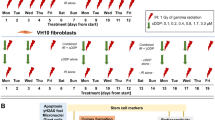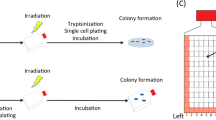Abstract
Previous studies have shown that the presence of epidermal growth factor (EGF) after irradiation enhanced the radiosensitivity of CaSki cells. To examine the role of EGF receptor density and related growth response in EGF associated radiosensitisation, four human squamous carcinoma cell lines were used. The total number of EGF receptors for HN5, A431, CaSki, and SiHa cells is 5.2 x 10(6), 1.6 x 10(6), 7.9 x 10(5) and 1.1 x 10(5) respectively, and the dissociation constant (Kd) for low affinity EGF receptors is 11.8, 3.8, 1.7 and 0.8 nM respectively. The Kd for high affinity receptors differs slightly among the four cell lines, 0.09 to 0.21 nM. EGF inhibited the growth of A431, CaSki, and HN5 cells, but stimulated the growth of SiHa cells. Due to the presence of 10 ng ml-1 EGF after irradiation, radiosensitivity enhancement associated with reduced shoulder size of the survival curve was observed. The extent of sensitisation was similar for A431, CaSki, and HN5 cells, with no effect on SiHa cells. At this concentration, EGF present during the clonogenic assay period after irradiation also reduced the plating efficiency (PE) of the monolayer cultures of A431, CaSki, and HN5 cells, but increased that of SiHa cells. The radiation response of mouse 3T3 cells (less than 5,000 receptors) was not sensitised by EGF. A similar level of radiosensitivity enhancement by EGF was observed for parental and conditioned A431 cultures. The conditioned cells were grown in 50 ng ml-1 EGF for 10 weeks and did not demonstrate growth inhibition and PE reduction by treatment with EGF. The EGF receptor numbers and binding affinity of these cells were the same as for the parental cells. The results from the conditioned cells support the hypothesis that EGF related radiosensitisation is EGF receptor density dependent.
This is a preview of subscription content, access via your institution
Access options
Subscribe to this journal
Receive 24 print issues and online access
$259.00 per year
only $10.79 per issue
Buy this article
- Purchase on Springer Link
- Instant access to full article PDF
Prices may be subject to local taxes which are calculated during checkout
Similar content being viewed by others
Author information
Authors and Affiliations
Rights and permissions
About this article
Cite this article
Kwok, T., Sutherland, R. Differences in EGF related radiosensitisation of human squamous carcinoma cells with high and low numbers of EGF receptors. Br J Cancer 64, 251–254 (1991). https://doi.org/10.1038/bjc.1991.286
Issue Date:
DOI: https://doi.org/10.1038/bjc.1991.286
This article is cited by
-
Epidermal growth factor receptor status and persistent activation of Akt and p44/42 MAPK pathways correlate with the effect of cetuximab in head and neck and colon cancer cell lines
Journal of Cancer Research and Clinical Oncology (2009)
-
Sequence-dependent effects of ZD1839 (‘Iressa’) in combination with cytotoxic treatment in human head and neck cancer
British Journal of Cancer (2002)
-
Dominant negative EGFR-CD533 and inhibition of MAPK modify JNK1 activation and enhance radiation toxicity of human mammary carcinoma cells
Oncogene (1999)
-
Augmentation of 5-fluorouracil cytotoxicity by epidermal growth factor in a newly established human signet-ring cell carcinoma of the stomach in culture
Surgery Today (1994)
-
Cell-signaling targets for antitumour drug development
Cancer Chemotherapy and Pharmacology (1993)



